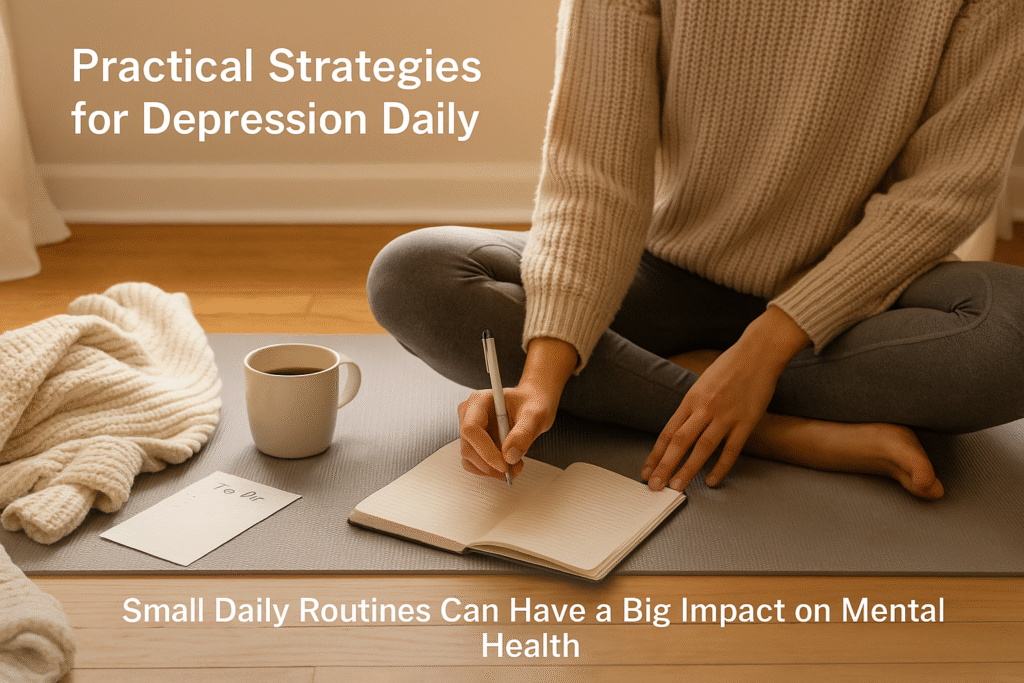Depression is one of the most common yet misunderstood mental health conditions today. If you’ve ever felt like you’re “not yourself” for days—or even weeks—and you can’t quite explain why, you’re not alone. Millions of people around the world silently carry this emotional weight every day.
This article will help you recognize depression: signs, symptoms, and treatment options so you can take the first step toward healing—whether for yourself or someone you care about. Let’s break the silence and get real about what depression actually looks like—and more importantly, what you can do about it.
Understanding the Different Types of Depression
Depression isn’t a one-size-fits-all diagnosis. It can show up in ways that are intense and sudden or subtle and long-lasting. Some people feel overwhelmed by sadness, while others just feel emotionally numb. That’s why it’s so important to understand the different types of depression—because treatment often depends on getting the right diagnosis.
According to the American Psychiatric Association, depression falls along a wide spectrum. Some types are triggered by specific events, while others seem to appear out of nowhere, rooted in brain chemistry or family history.
Major Depressive Disorder (MDD)
This is what most people think of when they hear the word “depression.” MDD is marked by a deep, lingering sadness or lack of interest in things that used to bring joy. It’s not about being in a bad mood—it’s about struggling to get out of bed, feeling worthless, and losing motivation to engage with life.
What it may look like:
- Feeling down or empty nearly every day
- Losing interest in favorite hobbies
- Struggling with sleep or eating too much/little
- Feeling tired no matter how much you rest
- Thoughts of self-harm or suicide (in severe cases)
Persistent Depressive Disorder (Dysthymia)
Imagine carrying a low-level sadness for months or years. It’s not intense enough to completely stop you, but it slowly drains your energy and self-esteem. That’s dysthymia.
Common signs include:
- Feeling “flat” or emotionally disconnected
- Saying “I’ve just always felt this way”
- Being highly self-critical
- Avoiding social interactions or responsibilities
Other Types of Depression
- Postpartum Depression – severe mood shifts after childbirth
- Seasonal Affective Disorder (SAD) – depression tied to changes in daylight
- Bipolar Depression – depressive episodes alternating with manic states
- Atypical Depression – includes mood reactivity and fatigue
Expert Insight:
Getting an accurate diagnosis is key. Many people spend years battling symptoms without knowing which type of depression they have—delaying the help they truly need.
Recognizing the Signs and Symptoms of Depression
Depression doesn’t always look like what you see in the movies. It’s not just someone crying in bed all day—it can be quiet, invisible, and hidden behind a smile. That’s what makes recognizing the signs of depression so important: you may not even realize you’re dealing with it until it’s deeply affecting your life.
The symptoms can be emotional, physical, and behavioral, and often show up differently in men, women, teens, and older adults. Knowing what to look for is the first step toward seeking the right kind of help.
Emotional and Cognitive Signs
- A persistent feeling of sadness or emotional numbness
- Hopelessness that doesn’t go away
- Irritability or frustration over small things
- Trouble focusing or remembering details
- Feeling worthless, ashamed, or overly guilty
- Constant negative thoughts or self-criticism
Physical and Behavioral Symptoms
- Low energy or constant fatigue, even after rest
- Changes in sleep—either too much or too little
- Loss of appetite or overeating
- Physical pain (like headaches or stomach problems) with no clear cause
- Withdrawing from friends or family
- Neglecting hygiene or responsibilities
- Using alcohol or substances to cope
Serious Warning Signs That Require Immediate Help
- Talking about feeling like a burden or not wanting to live
- Giving away personal belongings
- Sudden mood shifts or risky behavior
- Writing goodbye letters or searching online for ways to end life
Did You Know?
In older adults, depression often appears as physical complaints—like pain or memory problems—rather than sadness. This leads to frequent misdiagnosis or no diagnosis at all.

Exploring the Root Causes and Risk Factors of Depression
Depression doesn’t happen overnight—and it rarely has just one cause. For most people, it’s a mix of biology, life experiences, and daily stressors that build up over time. Some people may carry a genetic predisposition, while others develop symptoms after major life events like trauma, loss, or burnout.
Understanding these root causes and risk factors can make a huge difference in both prevention and recovery. The more you know, the more empowered you are to take control of your mental health.
Biological and Genetic Factors
- Chemical imbalances in the brain (serotonin, dopamine)
- Hormonal changes (thyroid issues, menopause, postpartum shifts)
- Genetic predisposition (family history)
- Chronic illnesses that wear down emotional and physical reserves
Psychological and Social Triggers
- Childhood trauma or emotional neglect
- High perfectionism or low self-esteem
- Isolation or lack of meaningful relationships
- Long-term stress, burnout, or life transitions
Expert Summary:
While you can’t change your DNA or your past, you can change how you respond to stress today. Building emotional awareness, creating social support, and seeking therapy are powerful ways to reduce your risk of depression—or to heal if you’re already in it.
Effective Treatment Options for Managing Depression
Here’s the good news: depression is treatable. And not just with one magic solution, but with a range of tools that can work together to help you feel like yourself again. What matters most is finding a path that fits your unique needs—because recovery looks different for everyone.
Most people benefit from a combination of professional care (like therapy or medication) and lifestyle changes that support emotional balance.
Therapy and Medication – The Clinical Route
- Cognitive Behavioral Therapy (CBT)
- Interpersonal Therapy (IPT)
- Psychodynamic Therapy
- Antidepressants (SSRIs, SNRIs, tricyclics)
- Combination therapy (medication + talk therapy)
Lifestyle Changes That Support Healing
- Regular movement or light exercise
- Better sleep habits and nighttime routines
- A nutrient-dense, brain-friendly diet
- Practicing mindfulness or meditation
- Staying socially connected in small ways
Did You Know?
Exercise has been shown in studies to be as effective as antidepressants for some people with mild to moderate depression.
Expert Summary:
There’s no “perfect” way to treat depression—but the right combination of professional care and daily habits can lead to powerful change. What matters most is taking the first step and being open to adjusting your approach as you go.
Practical Strategies for Coping with Depression Daily
When you’re living with depression, even the smallest tasks can feel impossible. Getting out of bed, replying to a text, or making a meal might seem like climbing a mountain. That’s why having simple, sustainable coping strategies is so important—they give you small wins that build momentum over time.
These daily practices don’t replace therapy or medication, but they work alongside treatment to support your healing and make daily life a little easier to manage.
Create a Daily Rhythm That Supports You
- Wake up and go to bed at consistent times
- Eat meals regularly, even without appetite
- Break tasks into micro-steps and celebrate small wins
- Keep a “done list” to track and validate progress
Build a Supportive Environment
- Clear clutter and open your space
- Let in sunlight during the day
- Use music or nature sounds to calm your mind
- Take intentional breaks from screens and news
Be Gentle With Yourself and Practice Emotional Self-Care
- Speak to yourself kindly—like you would to a friend
- Allow yourself to rest without guilt
- Journal, meditate, stretch, or breathe deeply
- Create one small “feel-good” habit per day

Expert Summary:
Small changes aren’t small when you’re healing from depression—they’re foundational. By creating routines, protecting your space, and showing yourself compassion, you build a stronger base to stand on—even when life feels heavy.
Conclusion
Depression isn’t a sign of weakness—it’s a signal that something deeper needs care, attention, and healing. If you’ve recognized yourself in the signs, symptoms, and treatment options for depression discussed in this article, know this: your pain is valid, and recovery is possible.
You don’t need to have it all figured out right now. The most important thing is taking that first step—talking to someone, reaching out for help, or even making one small change in your daily routine. Healing isn’t linear, but progress is always possible, even on the hardest days.
You are not alone. And you never have to face this alone again.
Further Reading
Looking to build more emotional resilience and mental clarity? Explore this next guide to support your healing journey:
The Benefits of Mindfulness Meditation







